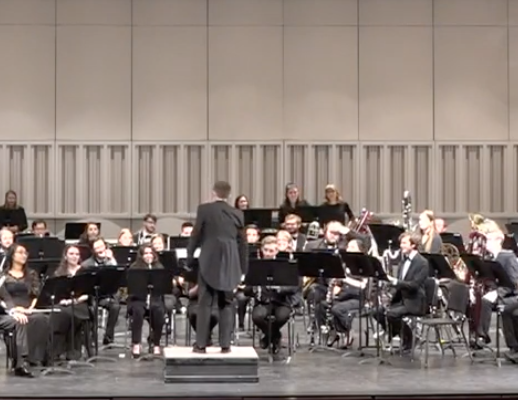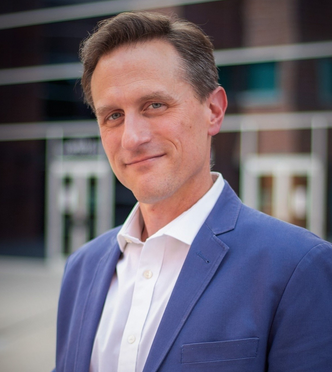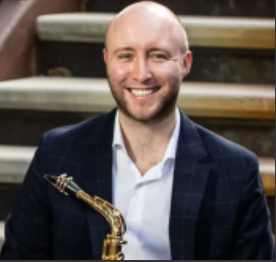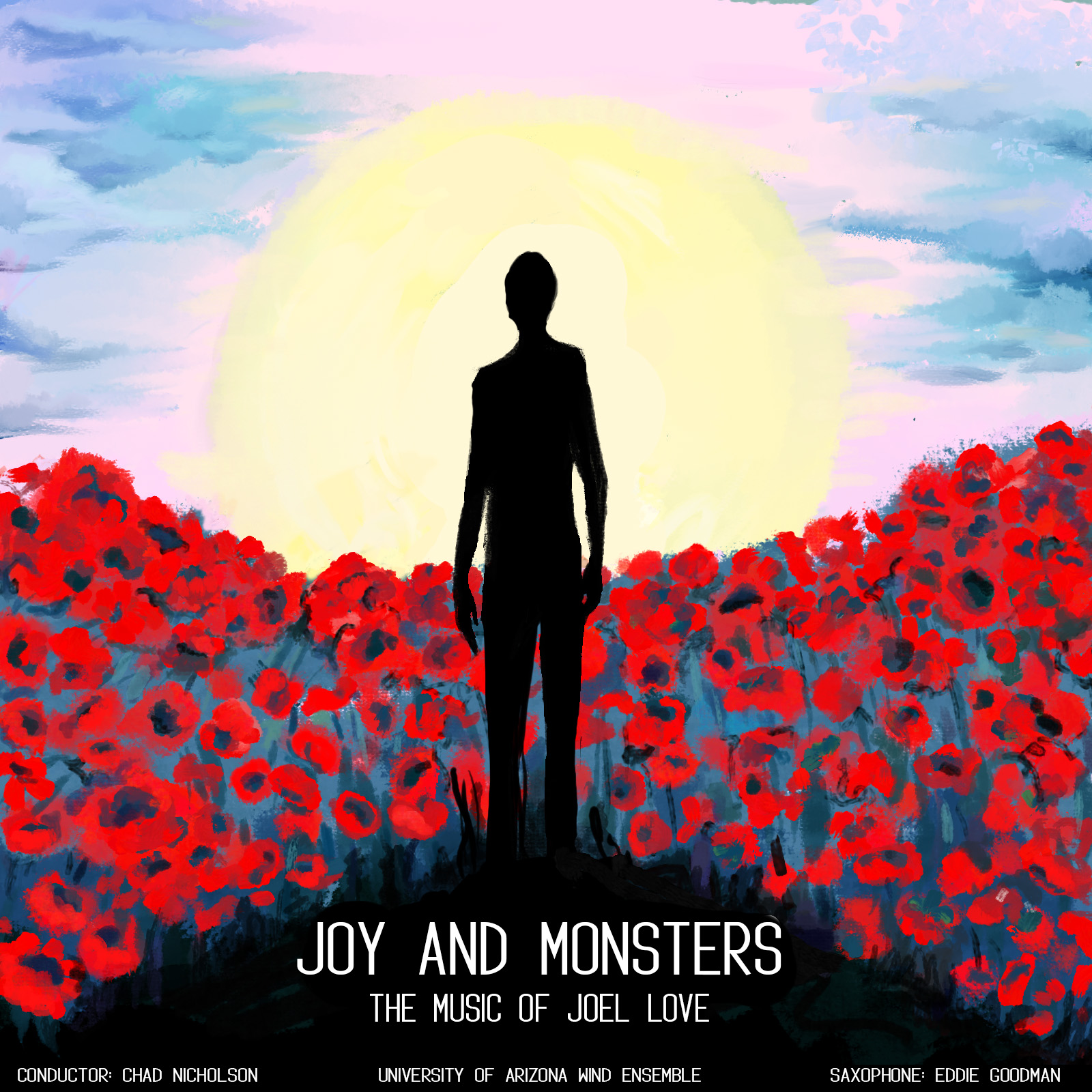
Fine Classical, Instrumental, and Specialty Recordings
Label: Soundset Recordings Item Number: SR1130 Format: CD Year Recorded: 2021 Joy and Monsters: The Music of Joel Love University of Arizona Wind Ensemble Chad R. Nicholson - Conductor Edward Goodman - Saxophone
University of Arizona Wind Ensemble  The UA Wind Ensemble and Chamber Winds represent a premiere group of brass, woodwind, and percussion students dedicated to the highest possible level of performance. This ensemble includes numerous concerts, sectional rehearsals, recordings, and occasional tours. The Wind Ensemble performs premieres of new works along with challenging standard repertoire. Primarily comprised of advanced undergraduate and graduate music majors, the UA Wind Ensemble and Chamber Winds demand a high degree of preparation and musicianship. The UA Wind Ensemble and Chamber winds have collaborated with many artists and scholars on and off-campus, including the Confucius Institute, the Flandrau Planetarium, David Maslanka, Aaron Jay Kernis, and Joan Tower. Additional Information: The group is open to any university student by audition in the fall of each academic year. Students should expect to commit to preparation and sectional times in addition to class meetings. Please contact uabands@cfa.arizona.edu for more information. Chad R. Nicholson - Conductor  Dr. Chad R. Nicholson is the Director of Bands at the University of Arizona Fred Fox School of Music where he conducts the University of Arizona Wind Ensemble, the Chamber Winds, and instructs the undergraduate and graduate wind conducting students. Dr. Nicholson is an active author and pedagogue; he has published articles in The Instrumentalist and in eight volumes of Teaching Music through Performance in Band. Additionally, he has published a book designed to aid conductors in repertoire selection and concert programming titled Great Music for Wind Band, and he is a contributing author for the recently published sourcebook for music educators, Engaging Musical Practices. Dr. Nicholson’s experiences as a music educator span all ages and ensemble types, including concert and athletic groups from public school through university levels. He has conducted many regional and All-State groups in addition to international bands. In 2014, Nicholson was the first conductor invited to lead the Shanghai International School Honor Band, and in 2015 he was a member of the distinguished international panel of adjudicators for the All-Chinese Wind Band Contest. Nicholson is a frequent presenter and performer at regional, national, and international conferences. Dr. Nicholson led his ensemble in performance at the Taiwan International Band Clinic in Taipei and at the CBDNA Eastern Division Conference. Nicholson has presented twice at the Midwest International Band and Orchestra Clinic in Chicago, and he was a clinician at the 2016 NAfME National In-Service Conference in Grapevine, Texas. in 2018, Dr. Nicholson will lead the UA Wind Ensemble in performance at the CBDNA Western/Northwestern Divisions Conference. He is also an invited guest conductor for the Beijing Wind Orchestra, China’s first and oldest professional wind ensemble. That performance will be the first of the 2018 Chinese New Year at the National Centre for the Performing Arts. Previous to his appointment at the University of Arizona, Dr. Nicholson served as a conductor at the University of Delaware, Indiana University-Purdue University Fort Wayne, and Colorado State University; he was a public school educator in Beaverton, Oregon and Lawton, Oklahoma. His primary conducting mentors include William Wakefield, Ken Van Winkle, Stephen Pratt and Ray Cramer. Nicholson holds degrees from the University of Oklahoma (BME), New Mexico State University (MM), and Indiana University (DM). Edward Goodman - Saxophone  Saxophonist Edward Goodman is a versatile emerging performer, improviser, educator, and scholar comfortable in a wide array of musical idioms. He has received numerous awards of regional and national acclaim, including first prize in the North American Saxophone Alliance National Classical Solo Competition, 1st prize of the Society of Musical Arts Competition, winner of Michigan State University’s Concerto Competition, and winner of University of Michigan’s Concerto Competition. Goodman serves as Soprano Chair and a founding member of The Moanin’ Frogs. First Prize Winners of the 2018 M-Prize International Chamber Arts Competition, their passion, quality, variety, instrumentation, and focus on the audience experience set them apart. With The Moanin’ Frogs, Goodman has performed at small towns to major performance halls alike throughout the US and abroad, such as The Kennedy Center in Washington, DC; Detroit Public Television; eight performances in and around the SaxOpen Festival Strasbourg, France; to rural Arkansas. The Moanin’ Frogs have entered into a partnership with the Conn-Selmer Division of Education, allowing the ensemble to give performances and interactive sessions with students nationwide. Their debut recording was released on Teal Creek Music in 2017. Other chamber ensembles Goodman has performed with include the internationally acclaimed PRISM Saxophone Quartet and the award-winning Donald Sinta Saxophone Quartet. An accomplished orchestral performer, Goodman regularly has been invited to serve as principal saxophonist of the Tucson Symphony Orchestra under José Luis Gomez, and has been invited to perform in the wind sections of the Detroit Symphony Orchestra under Leonard Slatkin, the Music Academy of the West Orchestra under Larry Rachleff, the New World Symphony under Jeffrey Milarsky, the Ann Arbor Symphony Orchestra under Arie Lipsky, and the University of Michigan Symphony Orchestra under Kenneth Kiesler. Equally at home in jazz as an improviser, Goodman regularly performs in chamber jazz settings. He was a regular member of The Phil Ogilvie’s Rhythm Kings, an early jazz big band based in Ann Arbor, MI. Being an avid promoter of new music, he has commissioned several pieces for the saxophone in a variety of mediums as a result of his versatility as an artist, commissioning repertoire by notable composers such as Gregory Wanamkaer, Daniel Asia, and Greg Simon. Goodman has been invited as a guest artist and clinician at several colleges across the country as well as internationally, including Michigan State University, Oakland University, University of Nevada Las Vegas, New Mexico State University, University of Massachusetts Amherst, University of Michigan, University of Oklahoma, Oklahoma State University, Southwestern Oklahoma State University, University of Memphis, Conservatoire à rayonnement départemental d'Aulnay sous Bois, France, and 2017 North American Saxophone Alliance Region 2 Conference. In the summer, Goodman serves on the faculty of the internationally renowned Interlochen Center of the Arts Saxophone Institute along with PRSIM Saxophone Quartet and has served on the faculty for Blue Lake Fine Arts Camp in Michigan. Edward Goodman is Assistant Professor of Saxophone at The University of Arizona Fred Fox School of Music. He holds a Doctorate of Musical Arts (2016) and Master of Music (2013) degrees in saxophone performance and improvisation from the University of Michigan where he studied with Dr. Timothy McAllister, Professor Donald Sinta, and Professor Andrew Bishop. At the University of Michigan, he was a recipient of the Lawerence Teal Fellowship. Goodman received Bachelor of Music degrees from Michigan State University (2010) in saxophone performance and music education where he studied with Professor Joseph Lulloff and Professor Diego Rivera. Hailed as "extremely moving" by New Music Box and "especially sweet" by the Austin American Statesman, the music of Joel Love (b. 1982) explores an eclectic mix of genres, from short video pieces to works for chamber and large ensembles. Joel is a recipient of a 2020-2021 Copland Residency Award. His first work for wind ensemble, Aurora Borealis, was selected as finalist in the 3rd International Franck Ticheli Composition Contest. Joel is also a two-time winner of the PARMA Recordings Composition Contest. Joel was commissioned to write a new work for string quartet, Lightscape, to accompany the opening of famed light artist James Turrell's Austin, TX Skyspace, The Color Inside. The Houston Chronicle commented that it "evocatively captures the emotion of The Color Inside." Joel’s works have been performed by a number of large and small ensembles (particularly saxophonists and wind ensembles, recently), exhibited at art galleries, and screened at theatres and festivals around the world. Most recently, Solace: A Lyric Concerto has been performed many times by wind ensembles throughout the United States, including the Eastman Wind Ensemble, Northwestern University Symphonic Wind Ensemble, and The US Air Force Band in D.C., among others. He recently wrote a clarinet and bass clarinet duo for the Égide Duo called The Threshold of the Year to Come, which chronicles some of the emotions we have felt throughout the pandemic. To close last year’s Library of Congress’ Stradivari Anniversary Concert, the Miró Quartet used Joel’s arrangement of “Silent Night” as a “sweetly turned encore” (WaPo). His film scores include the documentary film Stitched, official selection at the 2011 Carmel Art and Film Festival, as well as a short film Kidfellas, “Best Musical Score” at Houston’s 2011 48-Hour Film Project. Last year, Joel's score for Socks in the City won honorable mention for "Best Musical Score" at New York City's 2015 48-Hour Film Project. Other notable collaborations with artists from other disciplines feature a city-wide public art exhibit with artist Karyn Olivier, Inbound: Houston, and a 3-month installation by Prince V. Thomas, On Joy, On Sorrow at the Houston Center for Photography, praised by the Houston Chronicle as ”a beautiful piece that feels cleansing to watch." Joel recently completed a D.M.A. in Composition from the University of Texas at Austin and holds degrees from The University of Houston's Moores School of Music (M.Music) and Lamar University’s Mary Morgan Department of Music (B.Music). He lives in Houston, TX, where he teaches music at Houston Community College's Southwest location in Stafford, TX. Solace - A Lyric Concerto just before I began composing Solace, I had a great set of conversations with the leader of its consortium-commission, Connie Frigo. During our discussions, we talked about how well the saxophone can imitate vocal music and both expressed interest in a new concerto with a significant lyrical element. Early on, she suggested I read David Whyte’s Consolations: The Solace, Nourishment, and Underlying Meaning in Words. Whyte’s work meditates on words themselves, illustrating their deeper meaning, often revealing connections between difficult situations and their unexpectedly positive outcomes. Similarly, each movement meditates on a mood and is inspired by either a selection of text or title word from five consolations, picked by either Connie or me. Throughout the concerto, I challenge the soloist to play lyrically in extreme registers (called the “altissimo” register, which is above the typical, written range of the instrument) and while playing virtuosic passages in five unique sound worlds. Whyte describes joy as the “the sheer intoxicating beauty of the world inhabited as an edge between what we previously thought was us and what we thought was other than us,”[1] which is where “Joy” takes its inspiration. This movement highlights the soloist’s ability to play difficult syncopations, made even more challenging by their dissonance with the accented beats in mixed, irregular meters. In “Besieged,” the music expresses a darker sentiment. Whyte’s poem states that “Conscious or unconscious, we are surrounded not only by the vicissitudes of a difficult world but even more by those of our own making.” The saxophone is often pitted against or is competing back-and-forth with the wind ensemble, striving and fighting to overcome. The piece ends just after the climax and segues into the third movement, echoing Whyte’s sentiment that we must sometimes go through difficult challenges to be aware and grateful of what we have. The third movement is the heart of the concerto. Whyte states that “Gratitude is not necessarily something that is shown after the event, it is the deep, a priori state of attention that shows we understand and are equal to the gifted nature of life.” In “Gratitude,” my goal was to create the most beautiful and lyrical music I could to showcase the gorgeous vocal-like sounds of which the saxophone is capable. I would have been remiss to neglect any noir or jazz-influenced sounds, as the saxophone is oft-associated with the sounds of jazz and blues. “Hiding” is a scherzo that explores the jazz/funk idiom. Whyte states that Hiding is “creative, necessary and beautifully subversive of outside interference and control…Hiding is the radical independence necessary for our emergence into the light of a proper human future.” This movement is all about groove and its manipulation and the saxophonist, at times, gains a bit of “independence.” Finally, “Work” is a perpetual-motion technical showpiece. The movement is written in rondo form, which means the “A” part from the beginning returns several times. With every new section, the soloist is presented with a slightly different technical challenge. The inspirational text summates my feeling of writing this concerto and what I imagine the soloist feels as they accomplish this “Work”: “Work among all its abstracts, is actually intimacy, the place where the self meets the world…We make what we make, we give a gift, not only through what we make or do, but in the way we feel as we do, and even, in the way others witness us in our feeling and doing, giving to them as they give to us…” [1] Whyte, David. 2014. Consolations. Ebook. 1st ed. Langley, WA: Many Rivers Press. Used by permission of Many Rivers Press.
Three Images for Wind Ensemble This work (WE transcription) is available for purchase at Murphy Music Press, where you can also find a perusal score. These three movements all explore their own sound worlds. The first movement, “Spring” begins with three simple melodic movements, is through- composed, and is meant to depict a verdant springtime landscape in which people/animals are playing. “The Golden Hour” is a meditation on the image of the sun setting (or rising). In photography, the term “the golden hour” refers to the time just before and after sunrise/sunset, during which daylight is reddish and soft. Lastly, “Bed Monsters” is an unbridled rondo that is evocative of someone or something being chased by a predator. The title comes from my wife, Amelia, who thought it sounded like a monster lurking under the bed (from her childhood...). This transcription was premiered by the University of Arizona Wind Ensemble, Chad Nicholson, conductor, on Friday, April 26, 2019 in Crowder Hall.
Label: Soundset Recordings Item Number: SR1130 Format: CD Year Recorded: 2021 Recording Engineer: Wiley Ross (https://www.linkedin.com/in/wiley-ross-119b928) This album presents two new compositions by Joel Love performed by the University of Arizona Wind Ensemble and conducted by Dr. Chad Nicholson: 1) Solace–A Lyric Concerto, featuring saxophonist Edward Goodman, and 2) Three Images for Wind Ensemble. Not Available | |||||||||||||||||||||||||||||||||||||||||||||

 Amazon
Amazon Follow Us on Twitter
Follow Us on Twitter Follow Us on Instagram
Follow Us on Instagram Visit Our Partner Soundset Recordings
Visit Our Partner Soundset Recordings